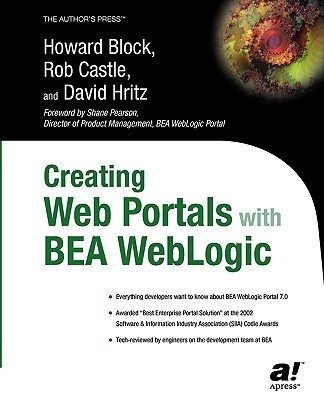
- We will send in 10–14 business days.
- Author: Rob Castle
- Publisher: Apress
- Year: 2003
- Pages: 624
- ISBN-10: 1590590694
- ISBN-13: 9781590590690
- Format: 17.7 x 23.8 x 3.9 cm, softcover
- Language: English
- SAVE -10% with code: EXTRA
Reviews
Description
WebLogic Portal is used to create Web sites, or more specifically, pieces of the sites or portlets. Combined these portlets can become a bigger part of the site, i.e. My Yahoo supports portlets, such as stock quotes, news, TV guide, etc. "Creating Web Portals With BEA WebLogic" shows the beginning portal developer how to develop a portal application from start-to-finish and supplies the intermediate developer with proven strategies and development tactics for creating an enterprise portal. It also provides the advanced Java application server developer with a full range of reference material. "Creating Web Portals With BEA WebLogic" also goes beyond portal development. The Web services chapter shows how to use Web services that allow companies to integrate business processes and data with their suppliers and customers. The authors describe the architecture of a well-planned user interface and include everything from data binding strategies to document-view architecture with MDI. They also show how to create elegant custom controls tailored to specific data and application logic and how to create dynamic user interfaces, dockable windows, and a vector-based drawing program. The book also teaches the GDI+ essentials needed for good user interfaces such as hit testing, irregularly shaped forms, owner-drawn menus, and animated controls, and shows how to integrate "intelligence" into user interfaces with embedded help and user agents.
EXTRA 10 % discount with code: EXTRA
The promotion ends in 20d.14:40:50
The discount code is valid when purchasing from 10 €. Discounts do not stack.
- Author: Rob Castle
- Publisher: Apress
- Year: 2003
- Pages: 624
- ISBN-10: 1590590694
- ISBN-13: 9781590590690
- Format: 17.7 x 23.8 x 3.9 cm, softcover
- Language: English English
WebLogic Portal is used to create Web sites, or more specifically, pieces of the sites or portlets. Combined these portlets can become a bigger part of the site, i.e. My Yahoo supports portlets, such as stock quotes, news, TV guide, etc. "Creating Web Portals With BEA WebLogic" shows the beginning portal developer how to develop a portal application from start-to-finish and supplies the intermediate developer with proven strategies and development tactics for creating an enterprise portal. It also provides the advanced Java application server developer with a full range of reference material. "Creating Web Portals With BEA WebLogic" also goes beyond portal development. The Web services chapter shows how to use Web services that allow companies to integrate business processes and data with their suppliers and customers. The authors describe the architecture of a well-planned user interface and include everything from data binding strategies to document-view architecture with MDI. They also show how to create elegant custom controls tailored to specific data and application logic and how to create dynamic user interfaces, dockable windows, and a vector-based drawing program. The book also teaches the GDI+ essentials needed for good user interfaces such as hit testing, irregularly shaped forms, owner-drawn menus, and animated controls, and shows how to integrate "intelligence" into user interfaces with embedded help and user agents.


Reviews